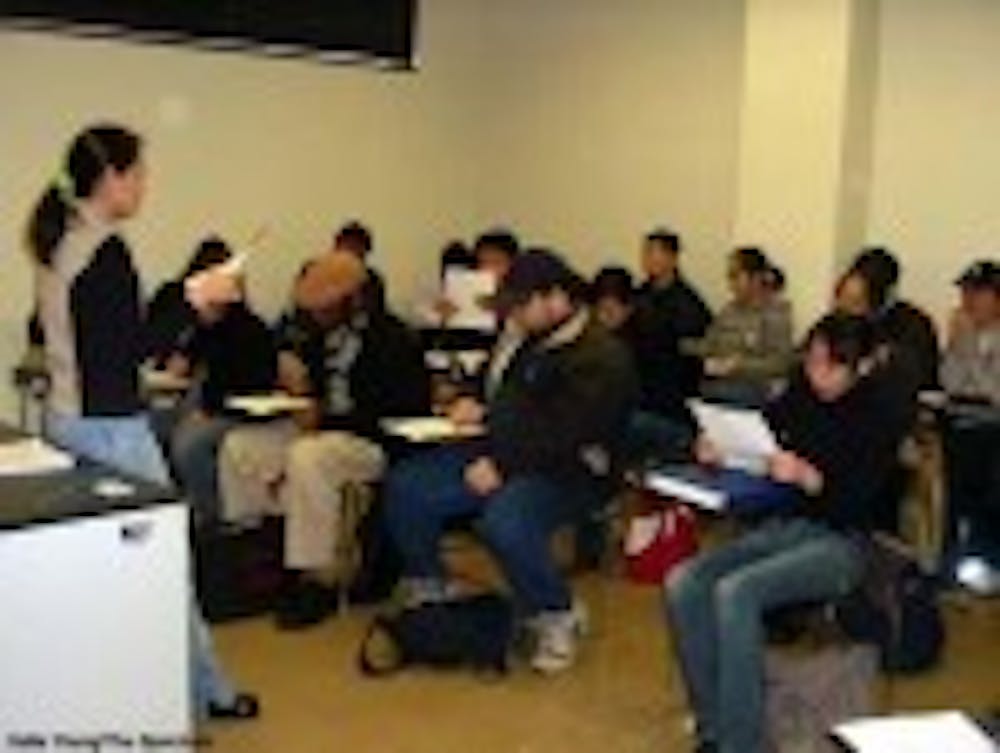This is part 2 of a two-part series exploring the expanding size of the UB classroom. The first part can be found here.
"Thou shalt not be boring" never made it onto Moses' tablet, but it is an integral part of "The 10 Commandments for Effective Teaching," one of the many presentations UB's Center for Learning and Teaching Resources gives its teachers every year.
"Teach unto others as you have others teach unto you," said Clyde Herreid, a professor in the biology department, during the presentation of his "Commandments" lecture in November. "Let's call that the golden rule."
The center sponsors a number of lectures that cover everything from working with international students to incorporating technology into the classroom. It also maintains a vast library of books, journals and videos that teachers can tap into to augment their teaching abilities.
Getting across to students in large lecture halls can be very challenging, an obstacle the Center for Learning and Teaching Resources. While most agree it's easier to reach students in smaller classes, given the size of many classes at UB, the center has become an important resource.
Professors can even have a lecture of theirs discretely recorded and evaluated, something Kerry Grant, vice provost for Academic Affairs and dean of the College of Arts and Sciences graduate school, says is sometimes a rude awakening.
"A lot of times what bedevils instructors in any class size is their mannerisms," said Grant. "They don't recognize they're spending two-thirds of the class facing the blackboard."
Grant insists large lecture halls can be a great place to foster learning, but instructors need to be sure they have a commanding presence that captivates the class.
"I don't teach a lecture as myself, I teach it in the mode as someone who has something to get across. I'll be more extroverted," said Grant, whose first teaching gig was a music appreciation class of 400 students.
"You address the class with a very outward, aggressive manner," said Grant.
No matter how engaging the instructor, however, small classes are better at fostering learning, according to some academics.
Jeremy Finn, a professor in UB's counseling, school and educational psychology department, says small classes are better learning environments because of his "firing line hypothesis."
According to Finn, students will be more alert if they know they can be called on at any time to answer questions or complete assignments.
"In a small class, every student is on the firing line," said Finn. "You can't go to sleep, the pressure is on the students to answer questions, and the pressure is also on the instructor."
Finn has dedicated his research to studying class sizes of elementary school students, but he said his firing line hypothesis applies to students of all ages.
The one sure place where Finn's theory will not work is in large lecture classes, such as World Civilizations. Finn says the students always need to be in the firing line of the instructor of the course, not a teaching assistant, as is the case in recitations.
"It's not good enough in a recitation," said Finn.
World Civilizations instructor Claire Schen, an assistant professor in the history department, agrees that recitations are not necessarily the best place to receive instruction. Schen says she wishes she could have a closer relationship with her anonymous students, but it is tough to bridge that gap.
"Despite the class size, I'm always trying to make a connection with students," said Schen.
Using audio and visual materials and encouraging students to attend her office hours are ways that Schen tries to make the class more enjoyable and less impersonal.
Schen calls the problem of class sizes the "umbrella problem." She says most complications in class stem from the fact that the class is too large.
"Sometimes there are issues with students talking in class," said Schen. "Students think I can't hear them but I can. In smaller classes that doesn't happen as often."
UB just enrolled its largest freshman class ever, so students can expect to see class sizes slightly increase. With the help of the Center for Learning and Teaching Resources, teachers can find assistance in handling the expansion, but it won't alleviate the fundamentally challenging dynamics of a large classroom setting.
Smaller classes seem to be what many UB students prefer.
"I'd rather be in a class with 10 than 100," said Travis Johnson, a sophomore media study major. "I like that because I know the professor has time for me. Even if I need to see him two or three times a week, I know he'll be there."





